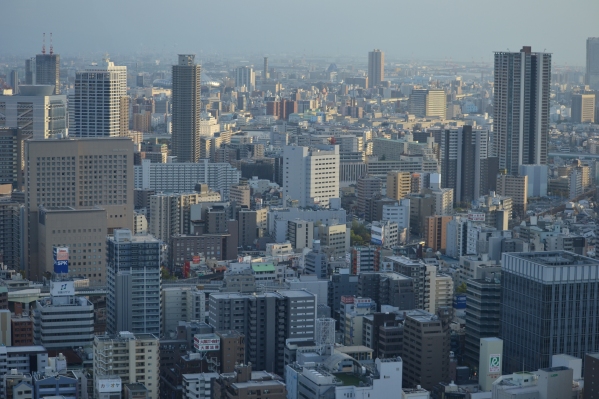
Osaka, at first glance, is a hard city to love. It seems to be 140 square miles of concrete, sardine-packed with tower blocks and criss-crossed with flyovers.
But the cherry blossoms along the Ō-kawa River temper the brutality of the concrete. The river parts and flows either side of Nakanoshima island, where the first mile or so has been landscaped and turned into a public park. It is a tranquil spot, lovely to walk through with a gentle breeze blowing off the river, and as you gaze at the lawns and the trees and the rose gardens, you might not even notice that the island is hemmed in by soulless office blocks.
Beyond the park, there is a hint of what Osaka might have looked like before the War in the 1912 Central Public Hall with its red and grey brick, stained glass and cupolas and the 1904 Prefectural Library with its monumental steps and columns.

The classical castle nearby was rebuilt in the twentieth century, but then so were most of the castles in Japan; if they were not burned down in the tumult of the Meiji Restoration, they were flattened in World War II. It is still impressive to see, and worth paying to go in for the museum with its samurai swords and suits of armour, screens and fans, woodcut prints and ancient scrolls, and the panoramic view from the top.
The Umeda Sky Building is the high-tech, modernist equivalent of the castle, designed, like it, to dominate its neighbourhood, to awe and intimidate, to exude power and wealth; and it has the best views in town. The lift scoots you almost to the top, then an elevator takes you through plate glass nothingness to the roof.
To the south and east, Osaka seems everlasting with office and apartment blocks fading to infinity. To the north, they are interrupted only by the broad expanse of the Yodo River, emptying out into the bay to the west.

At night, a million squares and circles of light glow in the windows, yellow lights swirl at street level, red lights pulsate on the rooftops, neon hoardings shimmer in blues and reds and greens, and the spokes of the giant Ferris wheel out on the harbour glow orange if the next day is set to be sunny, green if cloudy and blue if it is going to rain.
Amerika-mura (American village) got its name from shops selling second-hand Levis and Zippos and trades on it with Uncle Sam and Statue of Liberty models bursting from shop fronts and local interpretations of American fast food.
The vintage shops and street style stores blast J-Pop from the doorways to deter over-25s and to try to encourage the sullen girls in clumpy shoes and over-the-knee socks and giggly boys with spiky yellow hair to look briefly away from their smartphones.

A little to the east, the Shinsaibashi-Suji shopping arcade extends for a dozen blocks with all the world’s high street chains mixed up with noodle shops and pachinko* parlours, soundtracked one minute by J-Pop, the next by Vivaldi, and always by the staff in the shops shouting irasshaimase! when customers enter and arigatou gozaimashita! when they leave.
Shoppers jostle down the street with three bags hanging off each arm, mothers propel push-chairs, teenagers snigger in unruly groups, tourists stop and whip out their selfie sticks and the crowd eddies round them. At the end of each block, a road cuts through and the honking cars surprise you.
The mall empties out by the Dōtonbori Canal, where there are monster neon adverts wrapped round the ends of the buildings. The oldest and best-known is the marathon runner, who has been advertising the Glico confectionary company since 1935.

There is a crab restaurant round the corner which states its business with a massive 3D model of a spider crab above the door with claws that wave and eyeballs which extend in turn like pistons. Other restaurants along the street have taken up the theme and there are big puffer fish lanterns, an octopus, model gyoza dumplings, a giant hand holding nigiri-zushi and a life-size model cow.
There are bars and bowling alleys and amusement arcades. In the doorway of one, a salaryman, with his jacket off and sleeves rolled up, danced like your dad to the music from a game.
But just steps from all the sensory overload of Dōtonbori is a quiet corner with a temple dedicated to Fudo Myo-o, the deity of fury, where worshippers stop, pray and throw water over the diety’s statue, which is thick with moss from years of soakings.

There are cobbled alleys lined by izakayas** with nothing but the traditional red paper lanterns to advertise themselves, no mechanical crabs, no illuminated puffer fish, no model cows. I ate very well in one of them, sitting at the bar watching the chef prepare the food and serve it to me on a long-handled peel like bakers use to take loaves from the oven.
Sake was once served in a small wooden box called a masu, but the practice fell out of fashion. Izakayas, though, sometimes put a glass inside the masu and let the sake overflow into it to show how generous their measures are. Here, the chef, who was also the barman, carried on pouring until first the glass and then the masu overflowed.
I had misjudged Osaka. The ugliness I saw at first was nothing like as all-pervasive as I feared. While it is no Kyoto, it has a sprinkling of traditional sights, and a whole lot more which could not be reduced to items on a list of Top Things to See…, but which is rewarding to see nonetheless. Above all, though, it has an infectious joie de vivre which I never saw matched as I travelled through Japan.
© Richard Senior 2016
*Japanese pinball
**Bars which sell food – loosely like Spanish tapas bars